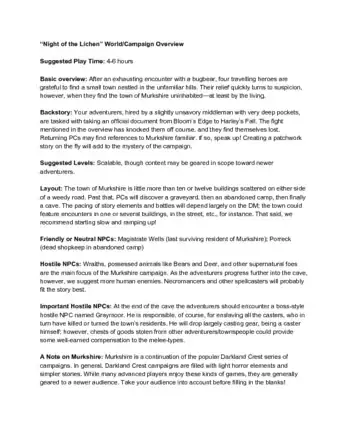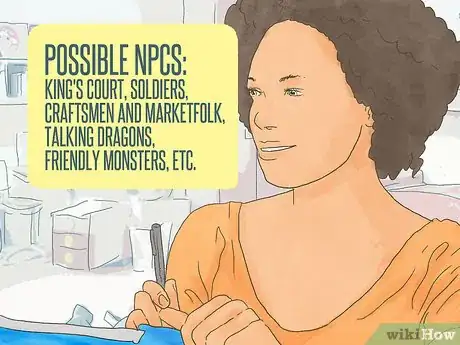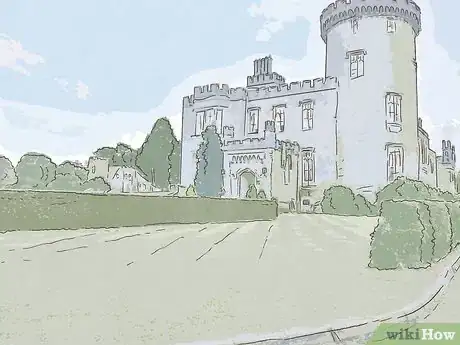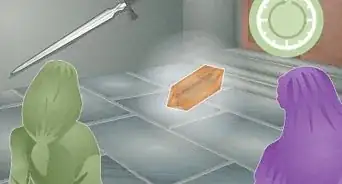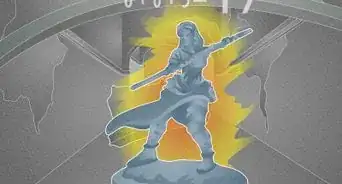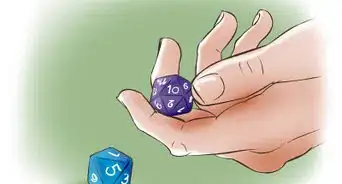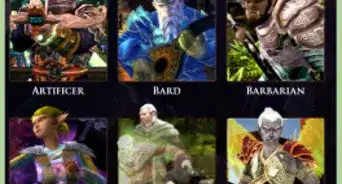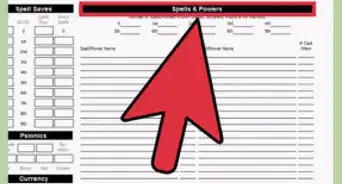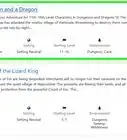This article was co-authored by wikiHow Staff. Our trained team of editors and researchers validate articles for accuracy and comprehensiveness. wikiHow's Content Management Team carefully monitors the work from our editorial staff to ensure that each article is backed by trusted research and meets our high quality standards.
There are 8 references cited in this article, which can be found at the bottom of the page.
wikiHow marks an article as reader-approved once it receives enough positive feedback. In this case, 86% of readers who voted found the article helpful, earning it our reader-approved status.
This article has been viewed 260,620 times.
Learn more...
Being the Dungeon Master (DM) of your own Dungeons and Dragons campaign requires some preparation and attention to detail. However, using the in-game mechanics of D&D will provide you the perfect stage for your homebrew campaign. After you establish the basic parameters, you can really dig in to creating your campaign in earnest. Then you can add depth to your campaign as you see fit.
Steps
Sample Campaigns
Basic Parameters
-
1Determine the scope of your campaign. Your campaign might be a one-off where you journey through a dungeon to slay a monster in a single session, but longer campaigns could require several sessions of play time before they're finally done. If you're trying to create a one-off, aim for simple goals for the players. Larger scope games usually involve some kind of intrigue or overarching goal of an enemy.[1]
- Some classic themes for campaigns include treasure hunting, saving the kingdom from danger, and slaying deadly monsters.
- If you want a truly epic campaign, you might send players on a crusade into hostile lands. This kind of setting provides plenty of opportunities for combat.
- Beginners may want to start with simple, one session campaigns to get the hang of DMing before moving to more complex ones.
-
2Identify the conflict of your campaign. The conflict of your campaign can be simple and direct, or it could be less obvious. A simple conflict might involve players being charged with the extermination of an evil wizard. A more complicated conflict might require players to discover a secret plot to overthrow the king.[2]
- Without conflict in your campaign, characters might feel at a loss for what to do. By having a definite conflict for players to contend with, this sense of aimlessness will be less likely to occur.
- If you plan on pitting player characters against an antagonist like a villain, it might help you to come up with a list of immediate and long-term goals for that villain. This way, you'll have a better idea of what the antagonist is doing at any point in the campaign.
Advertisement -
3List the non-player characters, if applicable. Non-player characters, also called NPCs, are an important part of many D&D campaigns. NPCs often guide characters throughout your campaign by offering advice and hints. When listing the NPCs in your campaign, it can help to write a short description for each one. This way, you can easily remember where that NPC is coming from and how they will interact with player characters.[3]
- NPCs are also a powerful way you can make your campaign seem more realistic. It's only natural that other non-player characters populate cities, towns, and farms in your campaign.
- Common NPCs players might encounter in your game include kings, queens, princes, princesses, dukes, duchesses, counts, countesses, barons, mayors, governors, knights, lieutenants, generals, shopkeepers, merchants, innkeepers, guilds, craftspeople, and more.
-
4Imagine the setting clearly. Since you as the DM will be describing the setting to players over the course of the game, it's a good idea to have a concrete idea of what kind of environment your campaign takes place in. Try to engage all five senses when you do so to make it easier for players to become immersed.[4]
- Many beginner D&D players overlook small details, like light. In a cave or dungeon, it's unlikely there will be much natural light. Be sure you remember to include this detail when running your campaign.
- It may help you to imagine your setting better if you write down the sensory perceptions for each location ahead of time.
Plot and Setting
-
1Devise your plot. Central to your plot should be whatever you have chosen as the conflict for your campaign. Plot can roughly be defined as the action that will occur no matter what the player characters do. These events will help to draw players into the story and entangle them with it.[5]
- An example of a plot point might be something like the assassination of an important NPC, like a queen or duke.
- Natural disasters are often times used as plot points with built-in conflict. These can be paired with a magical disturbance, like the meddling of an evil wizard, to create an interesting plot.
- It can be useful to plan consequences even for unlikely player actions. For example, if a player chooses not to fulfill a quest, you might have the kingdom hunt the player down as a criminal.[6]
-
2Draw your field(s) of battle. This could be anything from a ruined temple to an underground cavern. Your drawing doesn't have to be a work of art, but having it as a point of reference will help player characters coordinate action when battle begins.
- Simple shapes and labels work well when drawing a battle map. You might use squares to represent boxes, triangles to represent trees, and circles for boulders.
- It can take some time to draw your field of battle. To ensure the game is uninterrupted, you may want to draw your map before running your campaign.
- If you have player characters fighting in several different settings, you may have to draw several battle maps for your campaign.
- In some cases player characters may have important actions to fulfill in a town or city. Drawing a map for this kind of "social battle" can help players visualize things better. Most towns in D&D have at least a shop, tavern, and inn.[7]
-
3Establish the environment. There may be things in the environment, like plants or animals, that influence how characters act. For example, characters might use the vines of a jungle to create ropes to climb a cliff. You don't have to create an entire ecosystem, but a few features of your own invention will give your setting a unique appeal all its own. Each campaign will be different, but you may want to list as many concrete details as you find necessary.
- If there are violent or dangerous creatures active in your setting at night time, like wolves, bears, lions, or similar creatures, it might be important for players to set watch at night. If they fail to do so, you might come up with consequences, like supplies being eaten.
- You might base your environment off one that already exists on earth, like a jungle, forest, desert, or cave. You might even use one developed in a previous game you have played.[8]
-
4Set traps and account for unsafe terrain. Many of the environments explored by player characters will be dangerous or decayed. You should take this into consideration when planning. For example, you might have rotten flooring crumble beneath a player if they step on a certain space, or you might have enemies set traps ahead of time for unwanted guests.
- Some examples of common traps include pitfalls, chambers that fill with water, arrow traps, and falling rocks.
- Crumbling ledges, rotten trees, rotten flooring, loose rocks, and slippery surfaces are common terrain hazards.[9]
-
5Set your challenge rating. The challenge rating (CR) is a number given to establish the difficulty player characters will have with a beast or enemy. If the CR is higher than the level of player characters, it poses a serious threat. Beginning players may want to start with a low challenge rating.[10]
- The information of many monsters, beasts, and other enemies are available online. These online bestiaries often come with CR, base stats, and some flavor text describing the creature.
- In some cases, you may not know how to stat a certain creature you've created for your homebrew campaign. In this situation, you might give your creature the same stats as a similar, pre-existing creature.
-
6Populate and stat enemies, if applicable. Enemies could include monsters, wild animals, enemy NPCs, gods, and more. If there are enemies in your campaign, you'll need to choose what they are and stat them accordingly. Stats will help you determine the dice rolls of these enemies when player characters encounter them.
- Plan the position of enemy units on your battle map so you have a rough idea of how the action will take place once the battle begins.[11]
-
7Establish the starting point of your campaign. You'll need some kind of conceit to bring all the player characters together in a party. Oftentimes, characters will begin their adventure having just met in a tavern, or the characters could have been called to help the kingdom by an important NPC, like a king, governor, duke, or mayor.[12]
- A mysterious person may have sent all the player characters a message to meet outside a cave. This way, you might tie some other aspect of the plot in with its beginning.
Extra Details
-
1Include deities in your game. You may want to incorporate invented religions in your game to create a more immersive setting for players. Some versions of D&D even require certain kinds of characters to say prayers once a day to be able to use their special abilities. For example, a priest might not be able to heal a friend without saying prayers.
- Evil gods and their followers are often a compelling point of conflict player characters will have to contend with throughout your campaign.
- You could create your own group of gods using the D&D model as your basis. This model can be found in the core D&D books or online.
- Many experienced DMs have posted well thought out and nuanced pantheons of gods for other players to use online. [13]
-
2Give your campaign a backstory. This way you'll be able to answered any detailed questions players ask over the course of your campaign. However, you should be careful not to spend too much time over planning. It's very common for players to miss details that you may have spent hours coming up with.[14]
- Important NPCs often interact with player characters. In these cases, it can be difficult coming up with dialogue on the spot. Having a backstory for these NPCs may help you with this.
- The region your campaign takes place in may be feeling the effects of a significant event in the past, like a war or natural disaster. These details can help you establish the tone of your campaign.
-
3Add in side quests. This is a nice way of giving players a feeling of free-will in your game. Side quests can include small tasks, like delivering a letter, or more time consuming endeavors, like hunting and trapping a monster loose on the plains.
- Many games require a special quest item, like a rare kind of metal, to create a powerful weapon or relic. You might use this conceit for one of your side quests.[15]
-
4Invent unique, setting appropriate gear. Different settings will often call for different kinds of equipment. For example, if your setting takes place in rugged mountains, NPCs and towns will likely have ropes, climbing gear, and so on. Mountain towns might also have access to rare metals for powerful weapons. Plains villages, on the other hand, might have plenty of healing items and farming tools, but not much weaponry.
- You might include one or two important cultural items to tie in the story of your setting with NPCs. As an example, your setting might have people that worship a god of flight, and all NPCs might wear feathered necklaces to indicate their faith.
- When coming up with environment specific equipment, ask yourself, "What would this environment require for one to survive?" Arid cultures will likely value water highly, but polar climates will prioritize shelter, warmth, and snow tools.[16]
-
5Keep NPCs in character. While running your campaign, you may be tempted to adjust the actions of NPCs to make things more interesting. However, this can result in players feeling like you are manipulating events. Try to play NPCs as though they are independent from you and do not share your knowledge of the campaign.
Community Q&A
-
QuestionHow do I finish a campaign with full closure?
 Community AnswerIf the campaign has a story-arc that includes a main antagonist, you can end it with accolades/celebration after the villain has been defeated, encouraging the characters to retire with some sort of noble titles/positions (or to pursue professions or independent character goals). Otherwise, you could keep going until characters are level 20, or until they're gotten powerful enough that you can no longer present plausible challenge for them. Make sure previous storylines have been satisfied, and make it rewarding for the players.
Community AnswerIf the campaign has a story-arc that includes a main antagonist, you can end it with accolades/celebration after the villain has been defeated, encouraging the characters to retire with some sort of noble titles/positions (or to pursue professions or independent character goals). Otherwise, you could keep going until characters are level 20, or until they're gotten powerful enough that you can no longer present plausible challenge for them. Make sure previous storylines have been satisfied, and make it rewarding for the players. -
QuestionCould I make a player be the antagonist of the campaign (with the player's permission, of course).
 Community AnswerAbsolutely. This can be really effective if the player maintains the secret, sabotaging the rest of the party from within.
Community AnswerAbsolutely. This can be really effective if the player maintains the secret, sabotaging the rest of the party from within. -
QuestionHow do I level up my PCs?
 Community AnswerTo level up your PC, you need to acquire experience points (XP), which are awarded by the DM, usually from defeating enemies or finishing milestones in a campaign. After accumulating a certain amount of experience points, you gain a level and all the bonuses that come with it. Most of this can be found in more detail in the Player's Handbook.
Community AnswerTo level up your PC, you need to acquire experience points (XP), which are awarded by the DM, usually from defeating enemies or finishing milestones in a campaign. After accumulating a certain amount of experience points, you gain a level and all the bonuses that come with it. Most of this can be found in more detail in the Player's Handbook.
Warnings
- Creating and running a D&D campaign can be very time-consuming.⧼thumbs_response⧽
Things You'll Need
- Binder (optional)
- Paper
- Pens and Pencils
- Core D&D Books (Monster Manual, DM's Guide, and Player's Handbook; recommended)
References
- ↑ http://roleplayingtips.com/readissue.php?number=97
- ↑ http://dnd.wizards.com/articles/features/campaign-backbone
- ↑ http://kotaku.com/excellent-d-d-tips-from-a-veteran-dungeon-master-1606954012
- ↑ http://dnd.wizards.com/articles/features/campaign-backbone
- ↑ http://roleplayingtips.com/readissue.php?number=97
- ↑ http://dnd.wizards.com/articles/features/campaign-backbone
- ↑ http://dnd.wizards.com/articles/features/campaign-backbone
- ↑ http://geekandsundry.com/how-to-write-the-best-dd-adventures-ever/
- ↑ http://www.d20pfsrd.com/gamemastering/traps-hazards-and-special-terrains
- ↑ http://dnd.wizards.com/articles/features/building-adventures-0
- ↑ http://dnd.wizards.com/articles/features/building-adventures-0
- ↑ http://www.tribality.com/2015/02/13/world-building-part-1-the-big-picture/
- ↑ http://dnd.wizards.com/articles/features/campaign-backbone
- ↑ http://www.tribality.com/2015/02/13/world-building-part-1-the-big-picture/
- ↑ http://dnd.wizards.com/articles/features/campaign-backbone
- ↑ http://dnd.wizards.com/products/tabletop/players-basic-rules
About This Article
To create a Dungeons and Dragons campaign, start by devising a plot with a central conflict, like an assassination or natural disaster. Next, use simple shapes and labels to draw the field of battle, which can occur anywhere you choose. Then, establish setting details that affect how the characters approach the situation, such as the ability to use jungle vines to move around a jungle setting, and be sure to include unsafe terrain. Finally, set the challenge rating to establish the campaign's difficulty level. For more tips on drawing battle maps, read on!
